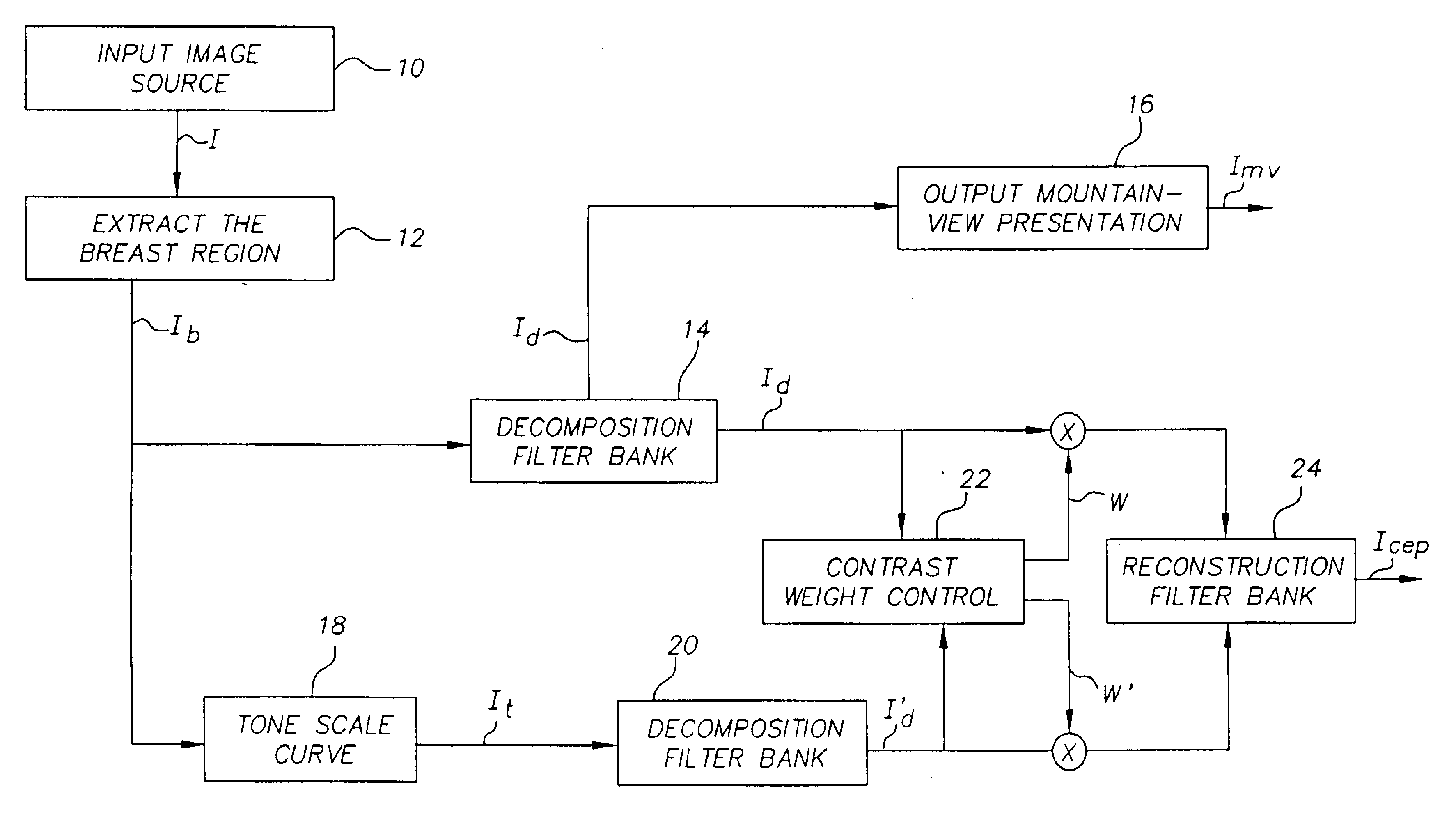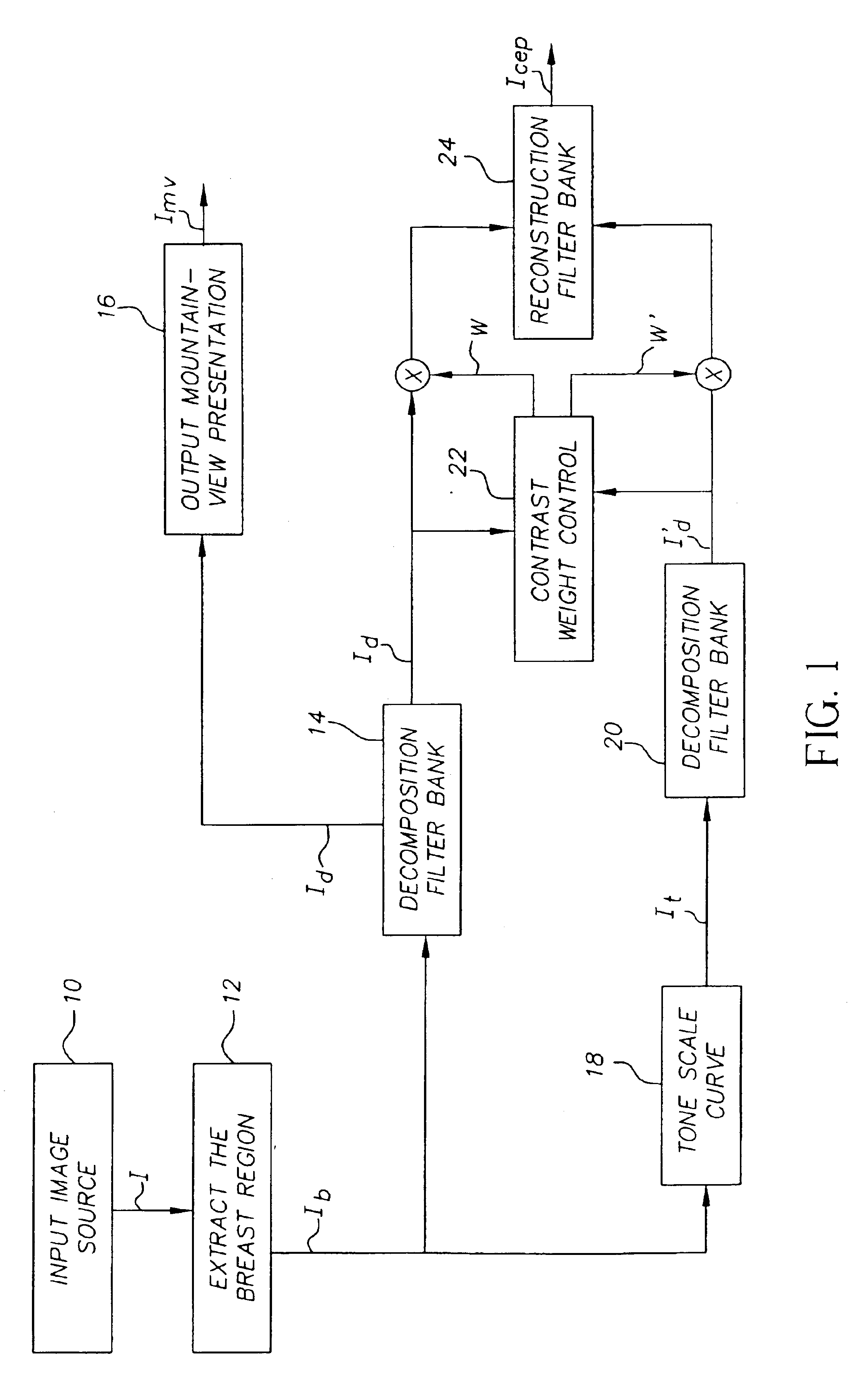Method for improving breast cancer diagnosis using mountain-view and contrast-enhancement presentation of mammography
a technology of contrast enhancement and breast cancer diagnosis, applied in image enhancement, instruments, applications, etc., can solve the problems of reducing the efficient use of radiologist's time, not all potentially detectable cancers are reported, and the second reading is expensive and time-consuming. , to achieve the effect of enhancing the contrast of breast images, reducing the number of search misses, and facilitating radiologist detection of breast cancer
- Summary
- Abstract
- Description
- Claims
- Application Information
AI Technical Summary
Benefits of technology
Problems solved by technology
Method used
Image
Examples
first embodiment
[0059]The invention as shown in FIG. 1 can be performed more efficiently by two different embodiments shown in FIGS. 7a and 7b. Instead of processing the original version of the input image and its tone-scaled version through the decomposition filter bank separately, the new embodiments only process one of the versions and the coarsest scale of the other version. FIG. 7a shows the first embodiment where the preprocessed image Ib is processed in the tone scale curve algorithm 50 to produce a tone-scaled image It. The tone-scaled image is then passed through a filter UN / 2 52 to produce the coarsest scale BN / 2,t. The preprocessed input image Ib, in another pass, is passed through a filter bank, consisting of a set of N decomposition filters F1, F2, . . . , FN, 541, 542, . . . , 54n. The main function of the filters 541-54n in this invention is to extract the image edge features, which are considered as desirable targets for enhancement. The output I1, I2, . . . , IN from each of the fi...
second embodiment
[0060]FIG. 7b shows the The preprocessed input image Ib is passed through two filters FN-1 and FN, 70, 72 to produce the coarsest edge signals, IN-1 and IN respectively. In a parallel path, the preprocessed image Ib is processed in the tone scale curve algorithm 74 to produce a tone-scaled image It. Then, the tone-scaled image is passed through a filter bank, consisting of a set of N decomposition filters F1, F2, . . . , FN, 761-76n, and one low pass filter UN / 2 78. The tone-scaled version output It1, It2, . . . , ItN from the filter bank is modulated in modulators in M1, M2, . . . , MN 801-80n by a gain-control signal G1-Gn, which is produced by the contrast weight control generator. The contrast weight control generator 82 in this embodiment is generated from all the output of the decomposition filter bank of the tone-scaled image It1-ItN as well as the output of coarsest scale of the original image Ib, IN-1, IN. Then the gain-adjusted signals I′t1, I′t2, . . . , I′tN, together w...
PUM
 Login to View More
Login to View More Abstract
Description
Claims
Application Information
 Login to View More
Login to View More - R&D
- Intellectual Property
- Life Sciences
- Materials
- Tech Scout
- Unparalleled Data Quality
- Higher Quality Content
- 60% Fewer Hallucinations
Browse by: Latest US Patents, China's latest patents, Technical Efficacy Thesaurus, Application Domain, Technology Topic, Popular Technical Reports.
© 2025 PatSnap. All rights reserved.Legal|Privacy policy|Modern Slavery Act Transparency Statement|Sitemap|About US| Contact US: help@patsnap.com



